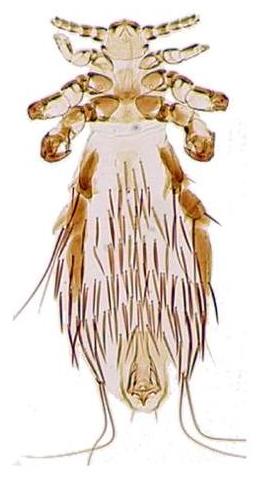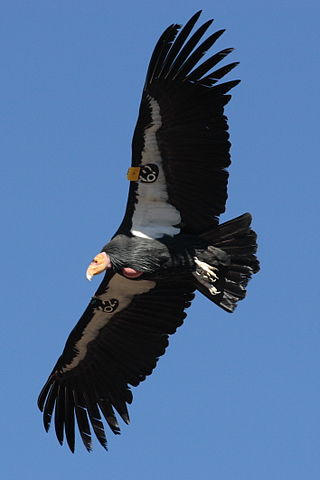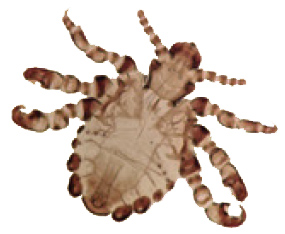
Extinction is the termination of a taxon by the death of its last member. A taxon may become functionally extinct before the death of its last member if it loses the capacity to reproduce and recover. Because a species' potential range may be very large, determining this moment is difficult, and is usually done retrospectively. This difficulty leads to phenomena such as Lazarus taxa, where a species presumed extinct abruptly "reappears" after a period of apparent absence.

Louse is the common name for any member of the clade Phthiraptera, which contains nearly 5,000 species of wingless parasitic insects. Phthiraptera has variously been recognized as an order, infraorder, or a parvorder, as a result of developments in phylogenetic research.

The Guadalupe caracara or mourning caracara is an extinct bird of prey belonging to the falcon family (Falconidae). It was, together with the closely related crested caracara, formerly placed in the genus Polyborus. It was also known as the quelili or the calalie.
Coextinction and cothreatened refer to the phenomena of the loss or decline of a host species resulting in the loss or endangerment of an other species that depends on it, potentially leading to cascading effects across trophic levels. The term originated by the authors Stork and Lyal (1993) and was originally used to explain the extinction of parasitic insects following the loss of their specific hosts. The term is now used to describe the loss of any interacting species, including competition with their counterpart, and specialist herbivores with their food source. Coextinction is especially common when a keystone species goes extinct.

The Guam rail is a species of flightless bird in the Rallidae family, endemic to the United States territory of Guam. It is known locally as the Ko'ko' bird. It was extirpated from the entire island by the late 1980s owing to the predation of the Brown tree snake, an invasive species not native to the island.

Menoponidae is a monophyletic family of lice in the superfamily of chewing lice, Amblycera, often referred to as the chicken body louse family. They are ectoparasites of a wide range of birds including chickens, which makes them important to understand for veterinary science and for human health. However, Menoponidae are not exclusive to poultry and are common parasites for migratory birds, with more and more species being discovered every year.

Sea lice are copepods of the family Caligidae within the order Siphonostomatoida. They are marine ectoparasites that feed on the mucus, epidermal tissue, and blood of host fish. The roughly 559 species in 37 genera include around 162 Lepeophtheirus and 268 Caligus species.

The New Caledonian rail is a large and drab flightless rail endemic to the island of New Caledonia in the Pacific. It is considered Critically Endangered or possibly extinct.
Extinction threshold is a term used in conservation biology to explain the point at which a species, population or metapopulation, experiences an abrupt change in density or number because of an important parameter, such as habitat loss. It is at this critical value below which a species, population, or metapopulation, will go extinct, though this may take a long time for species just below the critical value, a phenomenon known as extinction debt.

The salmon louse is a species of copepod in the genus Lepeophtheirus. It is a sea louse, a parasite living mostly on salmon, particularly on Pacific and Atlantic salmon and sea trout, but is also sometimes found on the three-spined stickleback. It feeds on the mucus, skin and blood of the fish. Once detached, they can be blown by wind across the surface of the sea, like plankton. When they encounter a suitable marine fish host, they adhere themselves to the skin, fins, or gills of the fish, and feed on the mucus or skin. Sea lice only affect fish and are not harmful to humans.

A large proportion of living species on Earth live a parasitic way of life. Parasites have traditionally been seen as targets of eradication efforts, and they have often been overlooked in conservation efforts. In the case of parasites living in the wild – and thus harmless to humans and domesticated animals – this view is changing. The conservation biology of parasites is an emerging and interdisciplinary field that recognizes the integral role parasites play in ecosystems. Parasites are intricately woven into the fabric of ecological communities, with diverse species occupying a range of ecological niches and displaying complex relationships with their hosts.

Pthirus gorillae or gorilla louse is a species of parasitic sucking louse that afflicts gorillas. It is found in the African continent, specifically in Rwanda and Democratic Republic of the Congo. P. gorillae and P. pubis are the only known species that belong to the genus Pthirus, often incorrectly spelled as Phthirus. It is suggested that it is transmitted among its hosts by social grooming, shared bedding and sexual contact.
Conservation is the maintenance of biological diversity. Conservation can focus on preserving diversity at genetic, species, community or whole ecosystem levels. This article will examine conservation at the species level, because mutualisms involve interactions between species. The ultimate goal of conservation at this level is to prevent the extinction of species. However, species conservation has the broader aim of maintaining the abundance and distribution of all species, not only those threatened with extinction. Determining the value of conserving particular species can be done through the use of evolutionary significant units, which essentially attempt to prioritise the conservation of the species which are rarest, fastest declining, and most distinct genotypically and phenotypically.
Columbicola extinctus, also known as the passenger pigeon chewing louse, is an extant species of phtilopterid louse. It was once believed to have become extinct with its only known host, the passenger pigeon, prior to its rediscovery living on band-tailed pigeons.
Bovicola bovis is a cattle-biting louse found all over the world. It is a common pest of cattle of all types and sizes. They are one of many of the lice in the order Phthiraptera, but are divided from their blood sucking cousins in the sub-order Anoplura by the fact that they feed only by chewing. This makes B. bovis a member of the sub-order Mallophaga.
Efforts to save endangered species may, paradoxically, lead to conservation-induced extinction of other species. This mostly threatens the parasite and pathogen species that are highly host-specific to critically endangered hosts. When the last individuals of a host species are captured for the purpose of captive breeding and reintroduction programs, they typically undergo anti-parasitic treatments to increase survival and reproductive success. This practice may unintentionally result in the extinction of the species antagonistic to the target species, such as certain parasites. It has been proposed that the parasites should be reintroduced to the endangered population. A few cases of conservation-induced extinction have occurred in parasitic lice.

Echinophthiriidae is a family of lice in the suborder Anoplura, the sucking lice. This family of lice are parasites of seals and the river otter, and are the only insects that infest aquatic hosts.

Colpocephalum is a genus of chewing louse. Christian Ludwig Nitzsch named the genus in 1818. The Plenary Powers of the International Commission on Zoological Nomenclature selected Colpocephalum zebraBurmeister, 1838 as its type species in the 1950s. There are approximately 135 species in this genus, and they are ectoparasites of birds in at least a dozen different orders.

Rallicola is a genus of chewing louse. It is an ectoparasite of rails and other birds. It was named by Thomas Harvey Johnston and Launcelot Harrison in 1911. There are two subgenera aside from the nominotypical subgenus: Aptericola, whose species are found on kiwi birds, and Huiacola, a monospecific subgenus consisting of Rallicola extinctus, once found on the huia.
Nyeema Charmaine Harris is an American environmental scientist who is Associate Professor and Director of the Applied Wildlife Ecology Laboratory at the University of Michigan. Her research considers mammalian carnivores and conservation.












